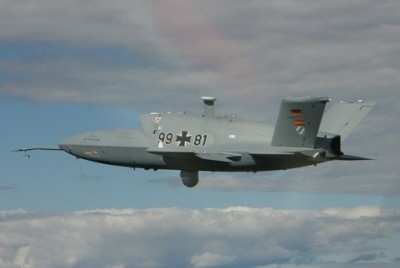Tue, Sep 21, 2010
UAV Demonstrator Completes Four Test Flights In Goose Bay,
Canada
In a series made up of four flights, EADS Defence & Security
(DS) successfully tested the technology demonstrator 'Barracuda' at
Goose Bay Air Force Base in Canada. Advanced technologies and new
procedures, including sense & avoid capabilities, auto taxi
systems, a structure integrated antenna and the image exploitation
chain, were checked under realistic conditions.

Barracuda UAV EADS Photo
During this 2010 test campaign in the Canadian province of
Newfoundland and Labrador, the jet-propelled UAV flew completely
autonomously along pre-programmed flight profiles including
auto-taxi. Flying some 2 hours and 42 minutes in four take-off and
landing cycles this summer, the Barracuda has reached an overall
total flight time of 4 hours and 15 minutes over 2009 and 2010. It
was monitored from the ground control station with respect to
flight safety only, while the payload ground station was used to
steer the on-board Zeiss EO/IR sensor with regards to different
modes and view angles from the ground as well as to receive the
sensor data.
These successful flights in Goose Bay have given EADS Defence
& Security practical confirmation of the results of technology
program testing it had previously conducted. The Barracuda
technology demonstrator was also used for test flights in the
"Agile UAV in Network Centric Environment" technology program
commissioned by the Federal Office of Defence Technology and
Procurement (Bundesamt fur Wehrtechnik und Beschaffung - BWB).
"The continued successful testing campaigns of the Barracuda
mark an extremely important step in the technological development,
enabling us to consequently increase our capability to offer a full
range of UAV products", stated Nicolas Chamussy, senior vice
president of Unmanned Aerial Systems at EADS Defence &
Security.
The test campaigns also enabled practical experiences in the
interoperability of UAS within Network-Centric (NEC) operations
conducted in line with the latest NATO criteria and in autonomous
operation involving interaction with other systems. The experiences
and results of this flight test campaign will be used for future
UAS programmes such as the Talarion.
More News
He Attempted To Restart The Engine Three Times. On The Third Restart Attempt, He Noticed That Flames Were Coming Out From The Right Wing Near The Fuel Cap Analysis: The pilot repor>[...]
Make Sure You NEVER Miss A New Story From Aero-News Network Do you ever feel like you never see posts from a certain person or page on Facebook or Instagram? Here’s how you c>[...]
From 2009 (YouTube Edition): Leading Air Show Performers Give Their Best Advice for Newcomers On December 6th through December 9th, the Paris Las Vegas Hotel hosted over 1,500 air >[...]
Aero Linx: NASA ASRS ASRS captures confidential reports, analyzes the resulting aviation safety data, and disseminates vital information to the aviation community. The ASRS is an i>[...]
“For our inaugural Pylon Racing Seminar in Roswell, we were thrilled to certify 60 pilots across our six closed-course pylon race classes. Not only did this year’s PRS >[...]
 NTSB Final Report: Rutan Long-EZ
NTSB Final Report: Rutan Long-EZ ANN FAQ: Turn On Post Notifications
ANN FAQ: Turn On Post Notifications Classic Aero-TV: ICAS Perspectives - Advice for New Air Show Performers
Classic Aero-TV: ICAS Perspectives - Advice for New Air Show Performers ANN's Daily Aero-Linx (06.28.25)
ANN's Daily Aero-Linx (06.28.25) Aero-News: Quote of the Day (06.28.25)
Aero-News: Quote of the Day (06.28.25)



